Campaign Poster from 1900 United States presidential election campaign of incumbent President William McKinley
and his choice for second term Vice President, Theodore Roosevelt
Topics on the Page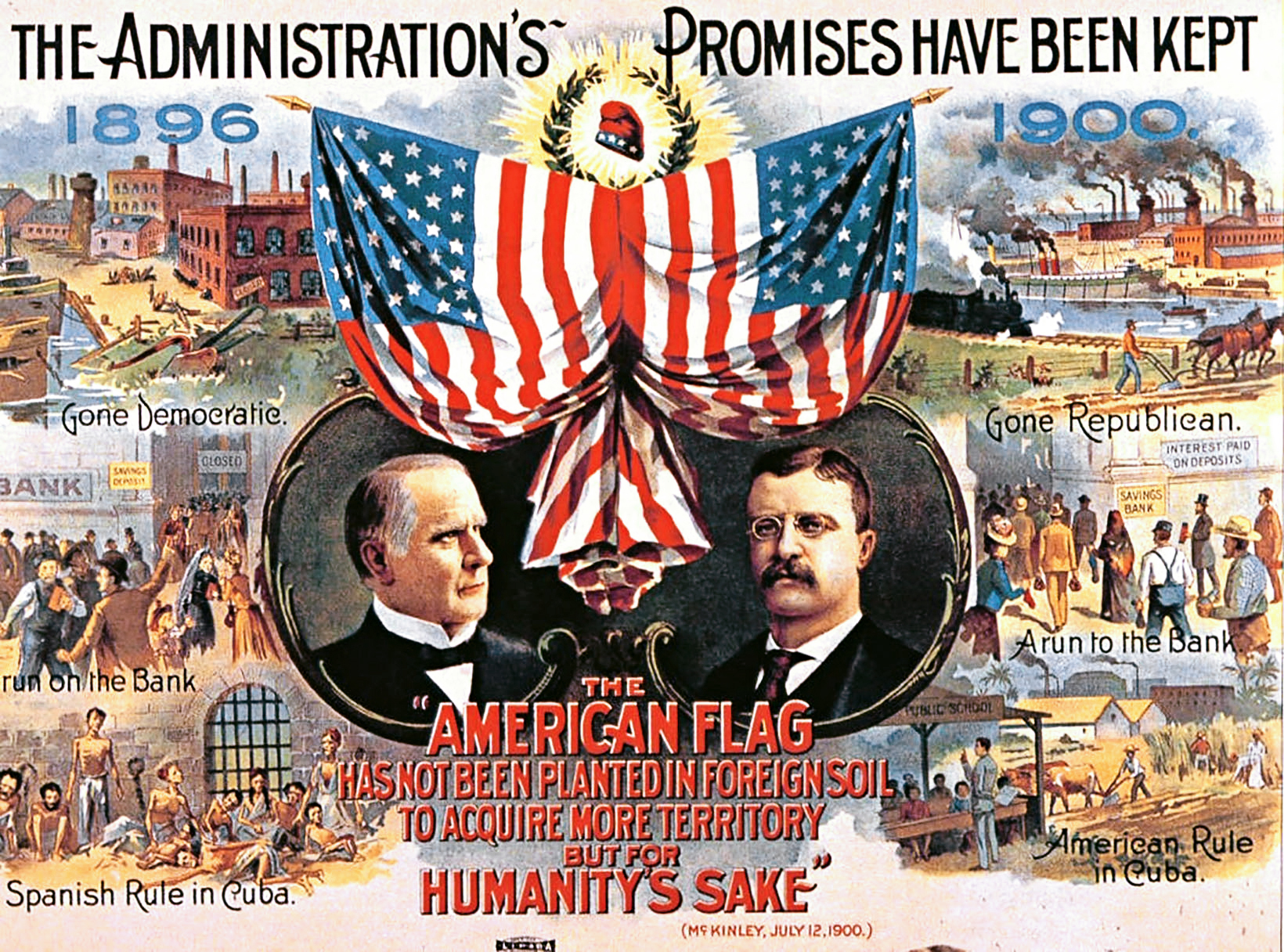
A. the influence of the ideas associated with Social Darwinism
B. the purchase of Alaska from Russia
C. Annexation of Hawaii
-
Dramatic Event page: Annexation of Hawaii
D. the Spanish-American War
- Yellow Journalism and the War
- Buffalo Soldiers: African Americans in the War
- Dramatic Event page: Philippine-American War, 1899-1912
E. U.S. expansion into Asia under the Open Door policy
- Dramatic Event page: The Great White Fleet
F. President Roosevelt’s Corollary to the Monroe Doctrine
G. America’s role in the building of the Panama Canal:
H. President Taft’s Dollar Diplomacy
I. President Wilson’s intervention in Mexico
J. America's Entry into World War I
- Harlem Hellfighters (Harlem's Rattlers)
- Dramatic Event page: Women in World War I
![]()
- Influential Literature page on All Quiet on the Western Front
Focus Question: What were the causes of America’s growing role in world affairs from the Civil War to World War I?
![]() Link to AP United States Key Concept 7.3: US as a World Power in the 20th Century
Link to AP United States Key Concept 7.3: US as a World Power in the 20th Century
![]()
- Though it occurred before the Civil War, the Opening of Japan was one of the first significant interventions in American Foreign Policy. Read Commodore Perry' account here.
Click Here for a Crash Course video on American Imperialism.![]()
- Click here for a lesson plan on the formation of an American Empire from EDSITEment
- Click here for a lesson plan on America's Rise to Global Power
 |
| U.S. Naval Base, Guantanamo, Cuba, 1916 |
Essential Understandings
- The United States became active internationally following the Civil War and leading up to World War I.
- This period saw the U.S. began to intervene in disputes between other countries
- sometimes leading to independence for one nation and sometimes leading to U.S. annexation.
- This era is marked most notably by the expansionist tendencies of most of the presidents and the nation.
- The land was acquired from all over and a war was even fought.
- The U.S., both its citizens and its government, were under the impression that the system here was the best
- our mission as a nation was to spread it into other areas.
- This period of time saw an increase in violence towards other nationalities
- Also saw the U.S. continuing its racist attitudes by making almost every non-white nation feel inferior.
A. Social Darwinism
Although the term "Social Darwinism" did not come about until far after Charles Darwin's On the Origin of the Species (1859), the school of thought was in existence before Darwin's work.
The most prominent Social Darwinist was a man by the name Herbert Spencer. Contrary to popular belief, evolution was not a revolutionary idea discovered by Darwin.
In fact, Spencer's major work, Progress: Its Law and Cause (1857), was published two years before On the Origin of the Species. Spencer also, while influenced by Darwin's theory of Natural Selection, was most influenced by Thomas Malthus, a political economist.
The concept of Social Darwinism developed even further throughout the next century but was most used during the Gilded Age to explain social patterns.
- It used Darwin’s theory of survival of the fittest and applied it to nations, races and even businesses. It caught on among many and is considered to be an elitist and racist belief. It was used to describe and understand how nations can better compete, endure, and evolve into a superior nation, race, etc. This was a common view held by those in power and able to call themselves “strong.”
- People in power used Social Darwinism as a tool to fuel systemic racism and also used it as a reason to expand and take over other areas. The industrial world also took on this concept.
- They applied it to business and claimed it was natural for them to take down the competition since they were stronger. This applied to many prominent businessmen at the time along with many theorists on the then ever-growing subject on race relations.
- Click here for a lesson plan on social Darwinism and their opponents.
- Click here for a lesson plan on social Darwinism and the American Dream
B. Purchase of Alaska
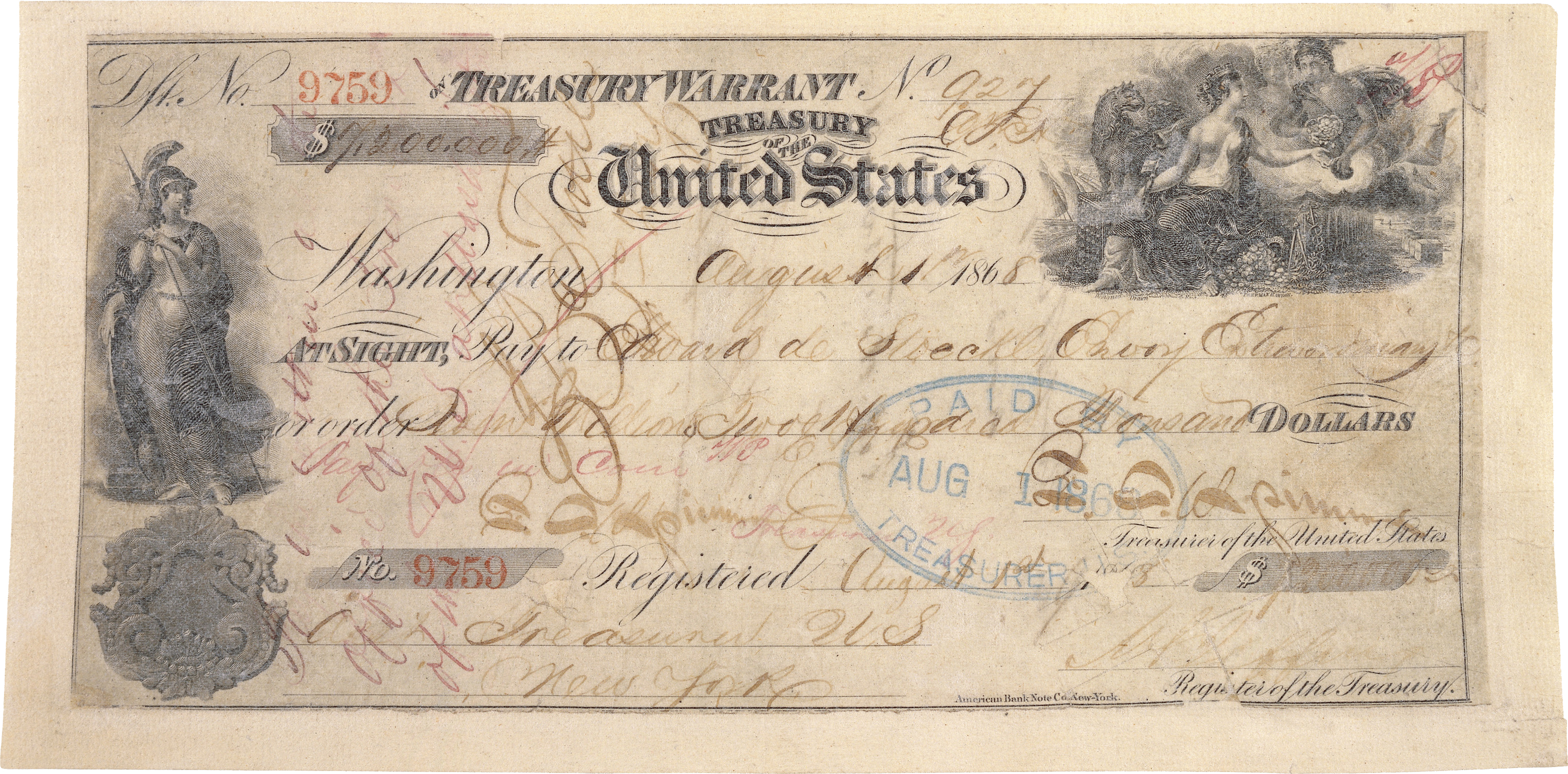 |
| U. S. Government Check for $7.2 Million for the Alaska Purchase |
Alaska was bought from Russia by the U.S. on October 18, 1867 [2] but did not become an actual state until January 3, 1959.
- Some in the U.S. including then-Secretary of State William Seward and Senator Charles Sumner favored a policy of expansion and Alaska seemed like the perfect spot to them.
- The British had control of most of Canada but this part belonged to Russia, who at the time was having serious financial problems.
- Russia also did not want to see the land fall into the hands of the British so they agreed to sell the land to the U.S.
- It took a little while for it to get approved by Congress and the main argument against it was that by taking that land we would be vulnerable to attack and we would also be taking land from a whole new group of aboriginals while at the time they were having difficulties with native peoples on the mainland.
- Originally, the purchase of Alaska was seen as trivial, but after the discovery of the gold in the Yukon, Alaska was recognized as valuable land to North America.
Click here for a lesson plan on the Purchase of Alaska
C. Annexation of Hawaii
See Dramatic Event page, Annexation of Hawaii for more on this event
D. The Spanish-American War
![]() Spanish-American War Worksheets from the National History Education Clearinghouse.
Spanish-American War Worksheets from the National History Education Clearinghouse.
The American Anti-Imperialist League and the Spanish American War (1902)
 |
| Naval Gun Crew in the Spanish American War |
The Spanish-American War began as a response by the U.S. towards the Spanish to end the insurrections that were occurring in Spanish-owned Cuba.
The 1898 Teller Amendment prohibited the United States from having control over Cuba.
- Link here for the text of the amendment.
The Teller Amendment was replaced with the Platt Amendment in 1901. This amendment permitted the United States to intervene to preserve Cuba's best interests and to create a government that would allow the people of Cuba protection of their life, liberty, and property.

The Role of Yellow Journalism
When the Maine, a U.S. battleship sank near Havana on February 16, 1898, American newspapers expressed outrage and sentiment for war grew in U.S.
- The Maine Blown Up (New York Times article from February 15, 1898
The role of newspapers in creating a climate for war has been called Yellow Journalism.
Yellow Journalism, from PBS Crucible of Empire
Yellow Journalism from The First Amendment Encyclopedia, Middle Tennessee State University
![]()
Learn about the accomplishments of Phoebe Apperson Hearst, mother of William Randolph Hearst
- The war resulted in the United States acquiring the Philippines, Guam, and Puerto Rico.
![]()
President McKInley's War Message
War began between the two nations and had many fronts but it ended pretty quickly, lasting a little over 100 days. The interesting concept here is that the prevailing notion in the U.S. at this time was that these lands were useful for colonization but that the people who inhabited them were not ready for U.S. citizenship. The U.S. was acting in a more imperialist manner than ever before.
Click here for a timeline of the Spanish American War
Click here for early movies from a Library of Congress site called The Motion Picture Camera Goes to War: The Spanish American War and the Philippine Revolution.
- Included is a video of the 25th Infantry, an all-Black regiment that fought in Cuba and the Philippines.
African American Troops (Buffalo Soldiers), Spanish American War
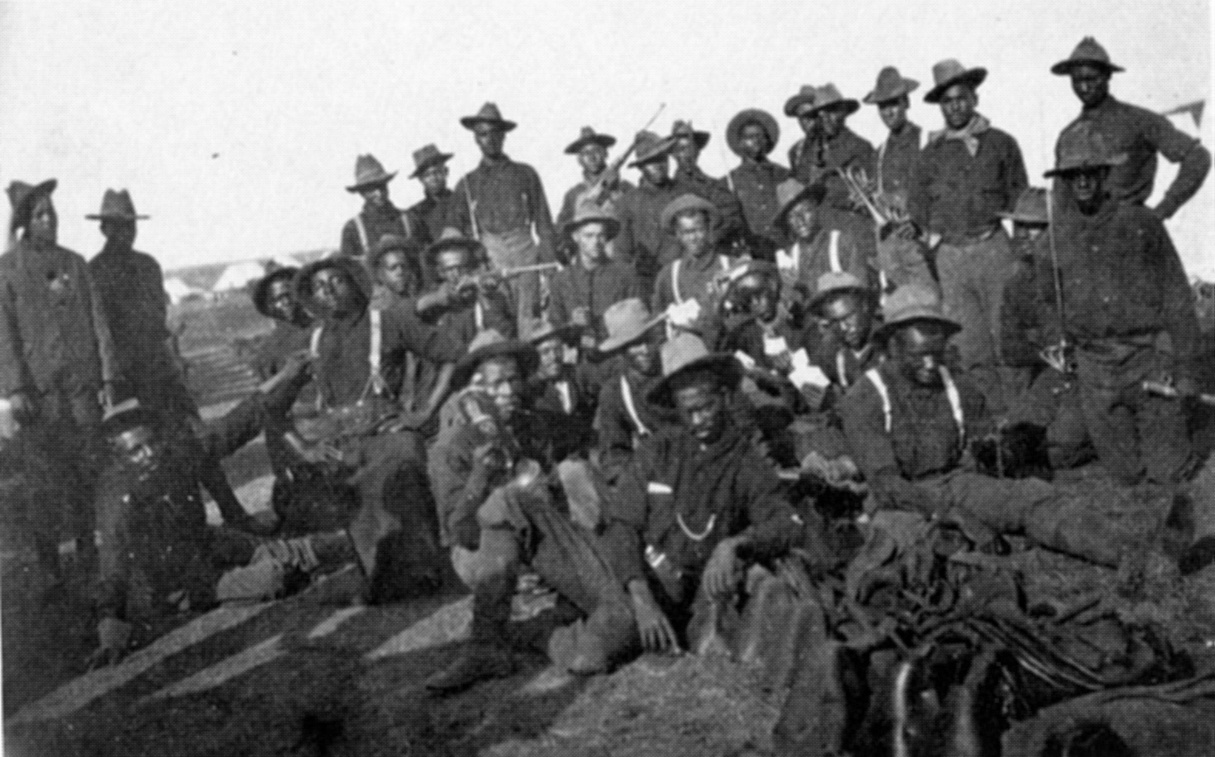
African American Soldiers in the Spanish American War
History Overview of the Buffalo Soldiers
Buffalo Soldiers and the Spanish-American War, National Park Service
Link to The Black "Immune" Regiments in the Spanish American War, U. S. Army National Museum
- Policymakers erroneously believed that African Americans were naturally immune to tropical diseases
Black Americans in the U.S. Military: Spanish American War and Philippine Insurgency, New York State Military Museum
The Rough Riders
Theodore Roosevelt organized the first voluntary cavalry in the Spanish-American War called the Rough Riders.
- This group consisted of cowboys, miners, law enforcement, and Native Americans.
- The group played a large role in the battle of Kettle Hill and San Juan Ridge. Click here for more details.
![]()
- Click here for a webquest on the Spanish American War from George Mason University.
- Click here for a lesson plan from the Ohio Department of Education on the Teller Amendment and American foreign policy
- Click here for lessons on the Spanish-American War using primary sources
E. American Involvement in the Philippines
For background on American involvement in the Philippines, see Honor in the Dust: Theodore Roosevelt, War in the Philippines, and the Rise and Fall of America's Imperial Dream. Gregg Jones, New American Library, 2012.
When the U.S. declared war on Spain, rebel armies were already fighting for independence from Spanish rule in both Cuba and the Philippines.
- Spain was on the verge of defeat. Washington declared that it was on the rebel's side and Spain quickly capitulated. But the U.S. soon made it clear that it had no intention of leaving the countries.
- The rebels fought the U.S. forces just as they had fought the Spanish.
- The U.S. subjugated the Philippines with brutal force. U.S. soldiers were ordered to "Burn and Kill all" and they did. By the time Filipinos were defeated 600,000 had died. (Andreas 2005)
Dramatic Event page for Philippine-American War
F. Asian Expansion and the Open Door Policy
Open Door Policy: https://www.britannica.com/event/Open-Door-policy
Image to the right is entitled "School Begins," a Political Caricature showing Uncle Sam lecturing four children labeled Philippines (who appears similar to Philippine leader Emilio Aguinaldo), Hawaii, Puerto Rico and Cuba in front of children holding books labeled with various U.S. states. In the background are an American Indian holding a book upside down, a Chinese boy at door, and a black boy cleaning a window. Published in 1899
The Open Door Policy [5] basically says that foreign nations should all have equal rights to access in China.
- The theory was arrived at to keep colonization out of China and to let all of the nations have access to the valuable resources within China.
- The U.S. was gaining a lot of power in the area following the Spanish-American War in which they gained the Philippine islands and other pieces of land.
- Each nation had interests in China and with this policy, no one nation would be able to have a lot of control.
- This ended following several breaches of the policy but once again, the U.S. showed that it had serious interest in other lands and wanted the resources from within those lands.
Click here for the lesson plan "Imperialism and the Open Door Policy"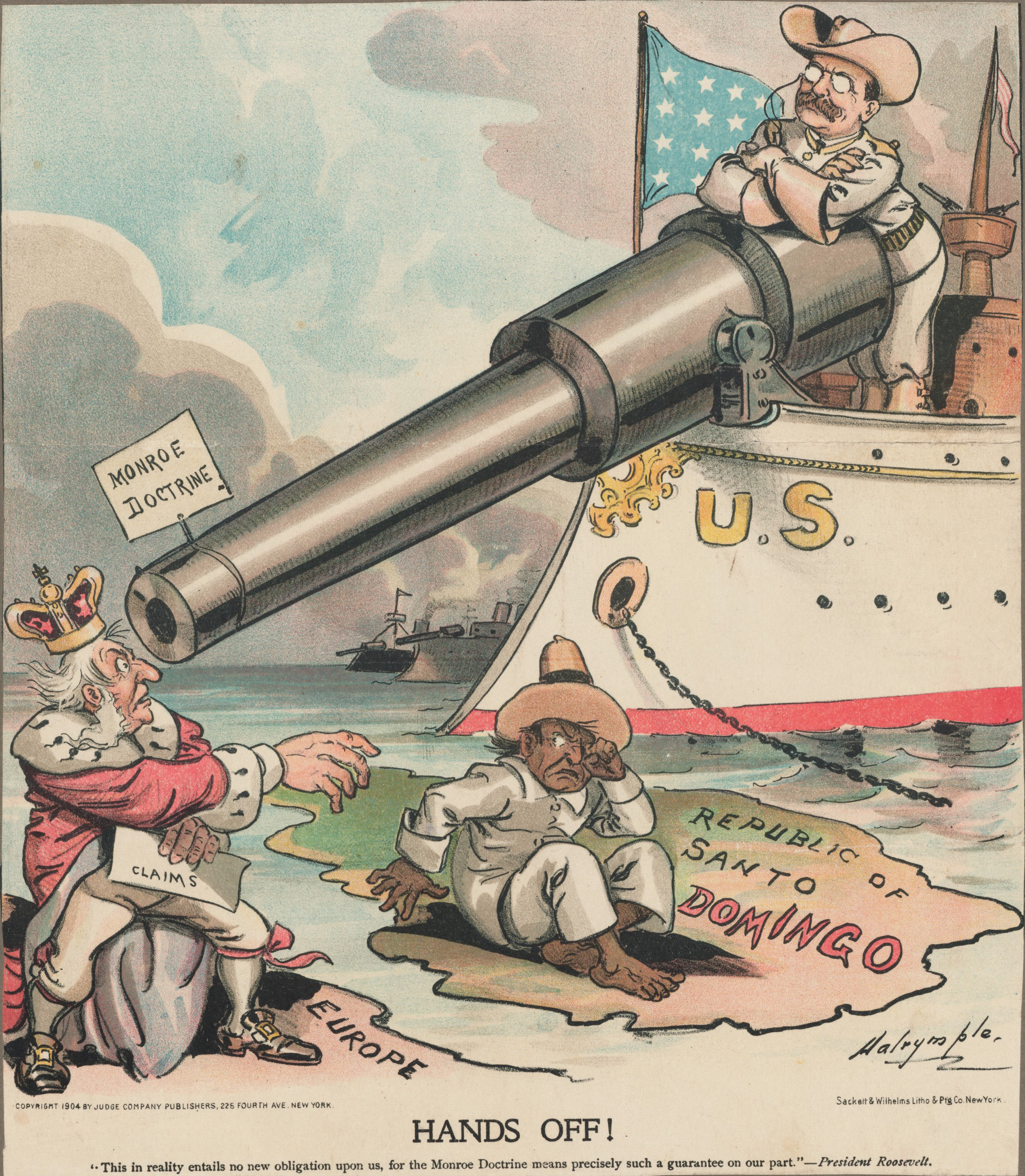
Roosevelt’s Corollary to the Monroe Doctrine
- The Monroe Doctrine was created during President Monroe’s administration
- It stated that European powers were no longer allowed to colonize land in the Americas.
- If European powers continued to do so then the actions they take would be seen as being hostile to the U.S. and would, in turn, require the necessary reaction towards hostilities.
- The Roosevelt Corollary added to this doctrine by now making it so the U.S. could interfere if nations in Latin America were unable to pay back debts by invading and bring the economy back to a stabilized point.
- It was originally intended to help these countries out and also keep European powers out who were the debt collectors in most of these cases.
- It turned into an excuse for the U.S. to start interfering in Latin America in order to further the interests of the U.S.
In 1905, the Russo-Japanese War ended in Portsmouth, New Hampshire. President Roosevelt was the one who was in charge of the peace conference. Read more about it here.
Click here for historian Walter LaFeber's interpretation of the Roosevelt Corollary.
Click here for a 3-minute video explaining the Roosevelt Corollary.
Click here for a lesson plan on the Roosevelt Corollary
| Route of the Great White Fleet |
To project its might around the world and to its new holdings, the United States commissioned a Great White Fleet to sail across the ocean and show the naval power of America.
Link to Great White Fleet Dramatic Event Page
G. The Panama Canal
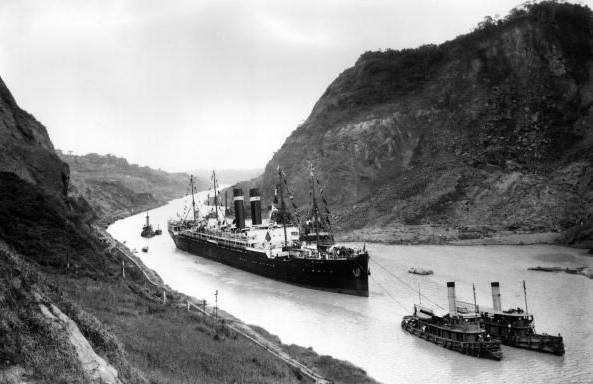 |
| Ship in the Panama Canal, 1915 |
Building of the Panama Canal Dramatic Event page
Following along with the course the U.S. was on at this point, President Roosevelt in 1904, led the U.S. into helping Panama gain its independence from Columbia. This of course was done in order to further U.S. interests. By doing so Panama gave the U.S. control of the area where the canal would be built.
Video on the building of the Panama Canal, from Modern Marvels
Click on this link for a Smithsonian exhibit on the building of the canal. The United States used it to its fullest extent until Panama gained full control of it in 1999. The U.S. put a lot of money into it and even helped to eradicate malaria from the area, but everything was done to further the U.S.’s imperialistic course.
- Click here for a virtual trip through the Panama Canal
Who built the Panama Canal? -From Research History .org
- During the US controlled building of the canal, workers came from Panama, Europe, Asia, and especially the West Indies.
- By the end of the first year, 20% of the 17,000 workers were from Barbados.
- This was because those from the West Indies were paid less and those from Barbados were not yet disenfranchised from work on the Canal (Jamaican workers had been largely taken advantage of during the French construction)
- At least 25,000 workers died during the combined periods of construction, largely due to unsafe building practices and diseases such as malaria, yellow fever, and pneumonia.
Visit here for resources from PBS's American Experience special on the Panama Canal, including videos, timelines & primary source documents.
H. Taft's Dollar Diplomacy
President William Howard Taft
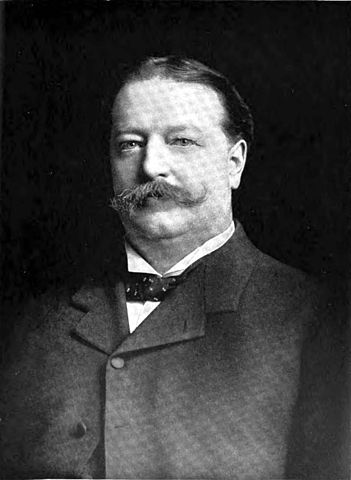
Dollar Diplomacy [8] is used to describe the efforts made by President Taft’s administration to bring U.S. businesses into Latin America.
- Encouraged investments in foreign countries to increase American power and influence
- Wanted Wall Street investors and private banks to invest privately
- The reasons for this were simple, the areas were in disarray and European powers could easily come in and set up businesses and gain influence.
- The U.S. began to do this and made sure Europeans knew they weren’t welcome to do the same.
- The term is used by those against it because the U.S. was trying to gain influence in the Latin America and Asian regions but doing so by exploiting the areas.
- Once Wilson became president he stopped using the policy.
American-historama.org gives a simple yet thorough overview on what specific strategies were involved in Dollar Diplomacy as well as countries where it was used.
Click here for more on Taft and Wilson
The Open Door Note, submitted by U. S. Secretary of State John Hay, September 6, 1899. The Russian Reply to the Open Door Note, December 18, 1899
 |
| Copy of the Zimmerman Telegram |
I. Wilson's Intervention in Mexico
The United States invaded Mexico 3 times within 1834 and 1989.
- Many groups in were fighting for power in Mexico and were willing to murder leaders to get it. The U.S. invaded and was trying to spread influence in the region.
- During the first Mexican Revolution, over 50,000 Americans owned land and lived in Mexico.
- The American government was concerned for their safety and intervened.
- President Wilson had many interactions with Mexico and tried on several occasions to use force in the area.
- He never solved any of the problems but the biggest event between the two occurred right before the U.S. entry into WWI. In 1914, American sailors were detained in Mexico.
- They were released, but the Mexican government refused to give a 21 gun salute. Wilson believed this would be an opportunity to take the Mexican ruler Victoriano Huerta out of power and asked Congress for a war declaration.
- Wilson ordered the Navy to seize a Mexican port without Congressional approval, which only made enemies with Mexican leaders.
- American military remained in Mexico until Wilson removed the troops to become involved in WWI.
Click here for more information on Wilson and Mexico
The Zimmerman Telegram was supposedly a letter that supported the belief of an alliance between Mexico and Germany. This was a massive fear of the U.S.’s and is seen as one of the main causes for the entry into the war.
Click here to check out U.S. involvement in Mexico between 1914 and 1917.
Click here for a timeline of Wilson's Presidency
J. America's Entry into World War I
Timeline of WW1: https://www.loc.gov/collections/stars-and-stripes/articles-and-essays/a-world-at-war/timeline-1914-1921/
See Historical Biography Page on Women in World War I
Why the US joined WW1: https://www.youtube.com/watch?v=fhTFWe8dbEk

The image below is a World War I era US poster by James Montgomery Flagg, 1918. The slogan "Every garden a munition plant" urges civilians to raise their own food to free up resources for the war effort
Historical Overview on American Entry into the War
In 1916, Germany attacked civilian ships in the English Channel. The US threatened to cut off diplomatic ties to Germany unless they pledged to stop their submarine attacks. Germany accepted the terms, which became the Sussex Pledge.
However, in 1917, Germany resumed their attacks in an attempt to defeat Great Britain. On January 19, 1917, the Zimmerman Letter was intercepted by the British. However, they did not tell the Americans about the message until February 24.
In February 1917, Wilson announced to Congress that he would not recognize Germany as a diplomatic country, but did not ask for a war declaration because he feared lack of public support.
However, American ships began to be attacked and American lives were lost. In late February 1917, Wilson asked that all American ships become armed and have US Navy on board. This was a controversial proposal and was rejected by Congress. Wilson used his Executive Order to arm US ships.
After growing public support, President Wilson approached Congress on April 2, 1917, for a declaration of war against Germany. Wilson was in support of war because Germany violated a pledge that suspended unrestricted submarine warfare and the fact Germany attempted to create an alliance with Mexico against the US.
On April 4, 1917, Senate approved the war declaration, and the House confirmed the vote on April 6, 1917. War was not declared on Austria-Hungary until December 7, 1917. Click here for more info.
![]() Link here to hear Over There, a patriotic song by George M. Cohan that was used to promote America's role in World War I.
Link here to hear Over There, a patriotic song by George M. Cohan that was used to promote America's role in World War I. Click here for an interactive timeline of World War I from PBS.
Click here for an interactive timeline of World War I from PBS.
![]() They Came to Fight: African Americans and the Great World War
They Came to Fight: African Americans and the Great World War
- Includes a primary source debate about African American participation between W.E.B. Du Bois & A. Phillip Randolph
Who Were the Harlem Hellfighters? Henry Louis Gates
- See the book Harlem's Rattlers and the Great War: The Undaunted 369th Regiment and the African American Quest for Equality by Jeffrey Sammons and John R. Morrow (2014) which uses the term Harlem's Rattlers.
- Click here for a lecture by Sammons about the book and this African American combat unit from New York.
- Click here for a gallery of WWI propaganda posters
President Wilson asking Congress for a war declaration on April 2, 1917

- Click here for audio recordings of WWI speeches
![]()
- Click here for newspaper pictorials from WWI. On the Library of Congress website.
- Click here for a document archive with WWI resources from BYU
- Click here for Wilson's First Warning to the Germans
- Click here for The First Lusitania Note to Germany
- Click here for first-hand accounts of WWI, including Wilson asking for a war declaration
![]()
- Click here for a lesson plan on US entry into WWI
Link here for two World War I trench warfare simulation games
Links
[2] (March 7, 2006). Treaty with Russia for the purchase of Alaska. Retrieved April 26, 2007, from Library of Congress Web site: http://www.loc.gov/rr/program/bib/ourdocs/Alaska.html
http://www.state.gov/r/pa/ho/time/gp/17662.htm
[5] Open Door policy. (2007). In Encyclopædia Britannica. Retrieved April 24, 2007, from Encyclopædia Britannica Online: http://www.britannica.com/eb/article-9057176
[7] (April 14, 2006). The Builders of the Panama Canal. Retrieved April 26, 2007, Web site: http://www.czbrats.com/Menus/Builders_menu.htm
[8] Ferraro, V. William Howard Taft: Dollar Diplomacy. Retrieved April 26, 2007, from Mount Holyoke Web site: http://www.mtholyoke.edu/acad/intrel/taft2.htm
(9) Andreas, Joel. Addicted to War; Why the U.S. can't kick militarism. 2005 AK PRESS. Retrieved April 2012